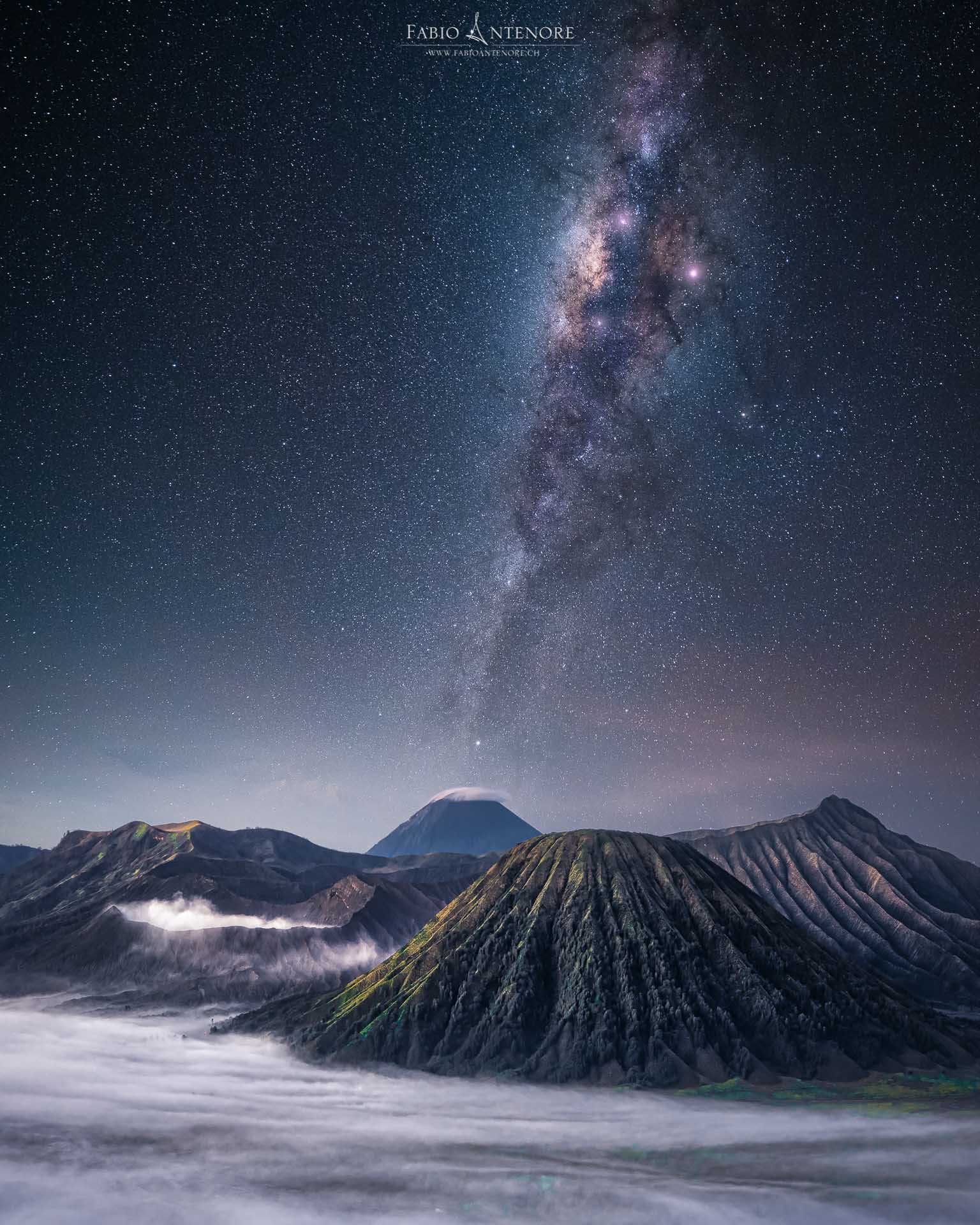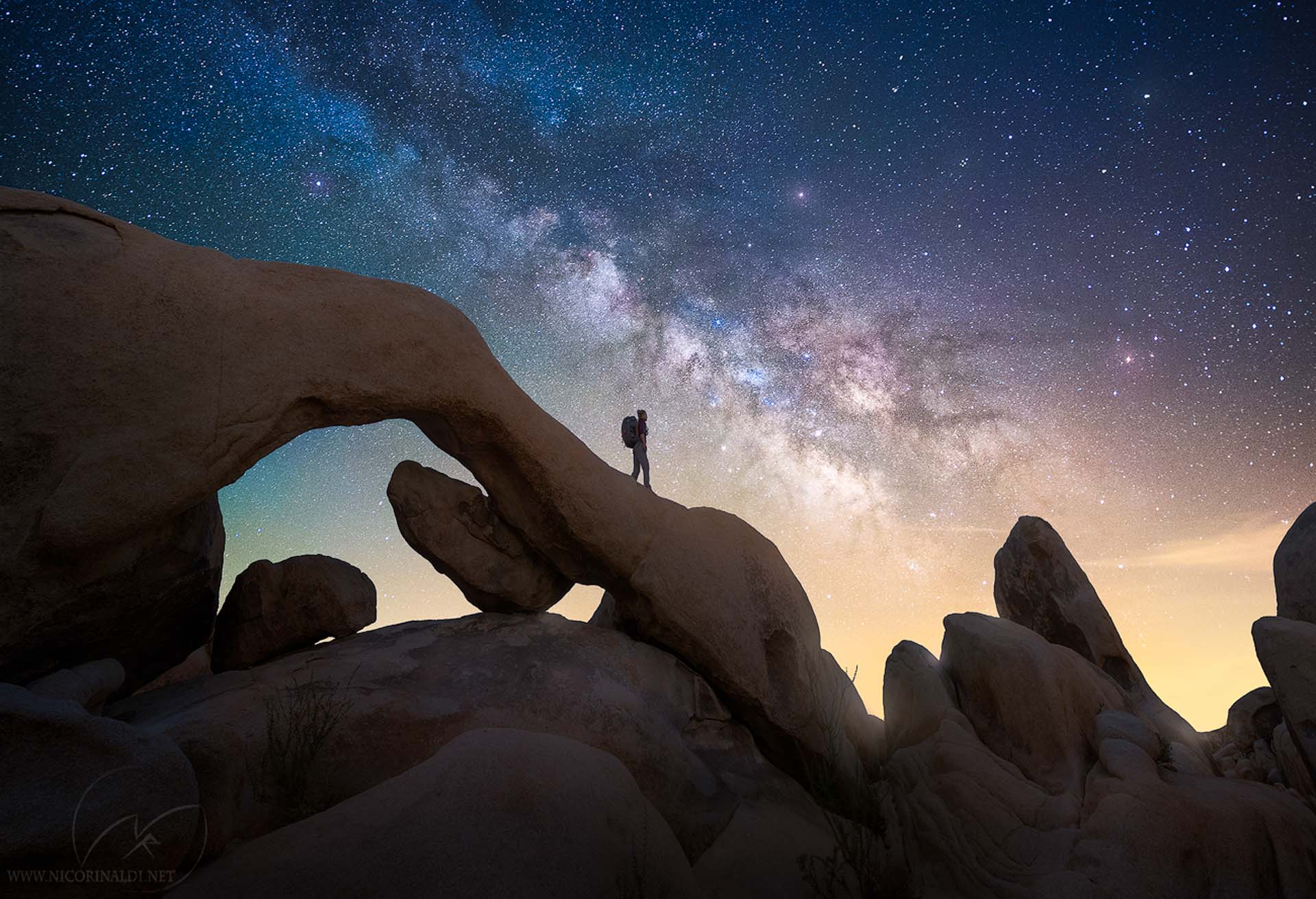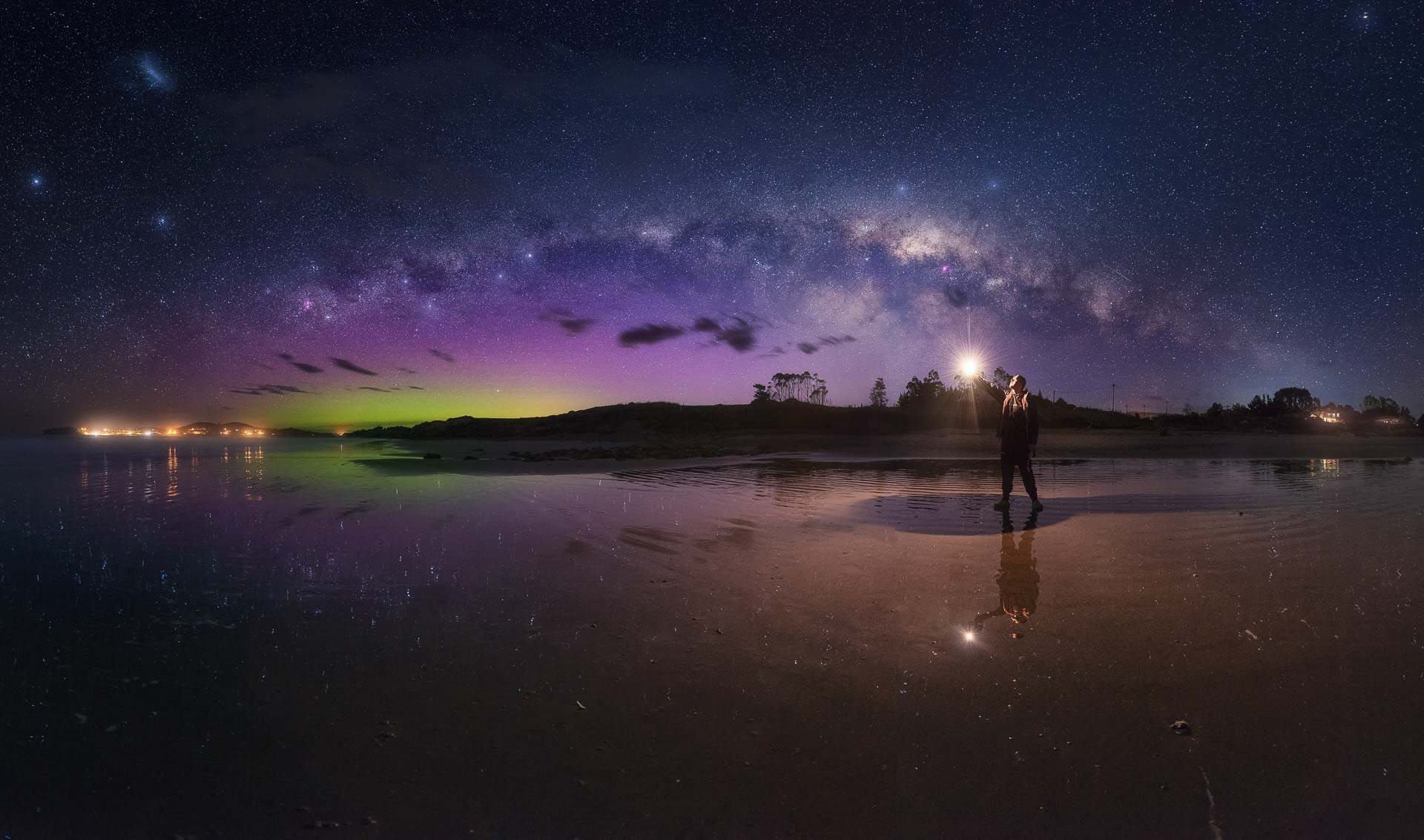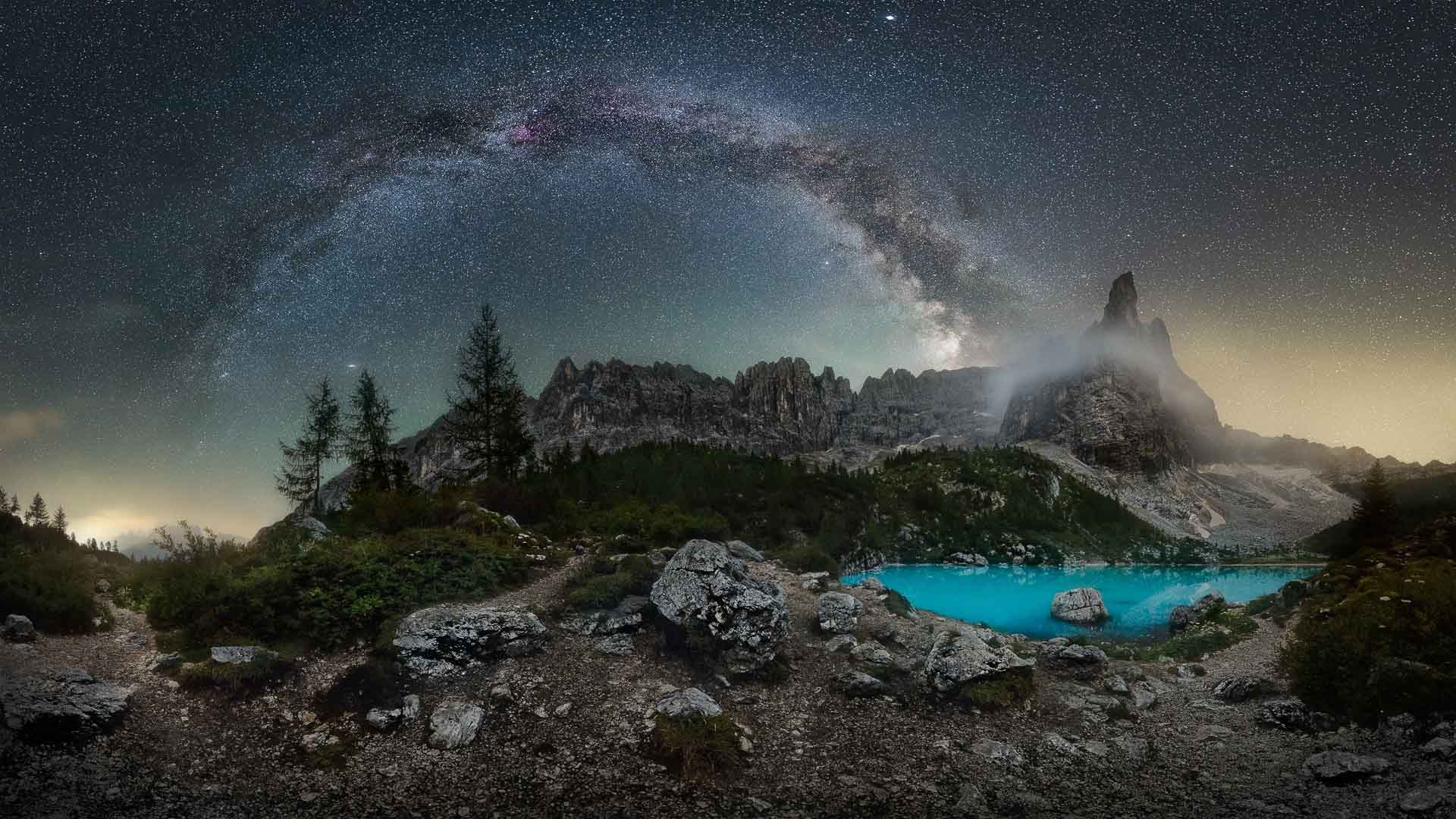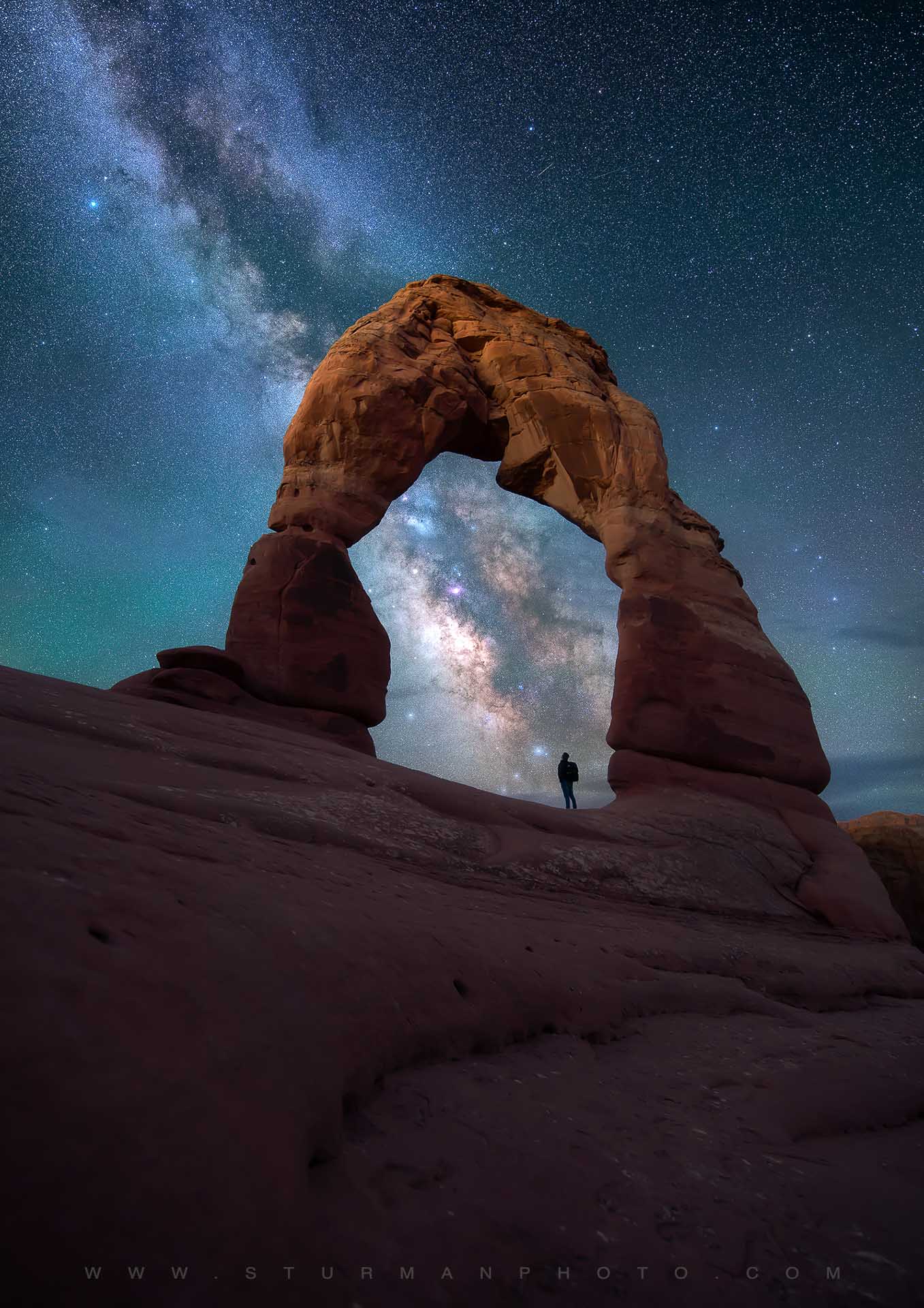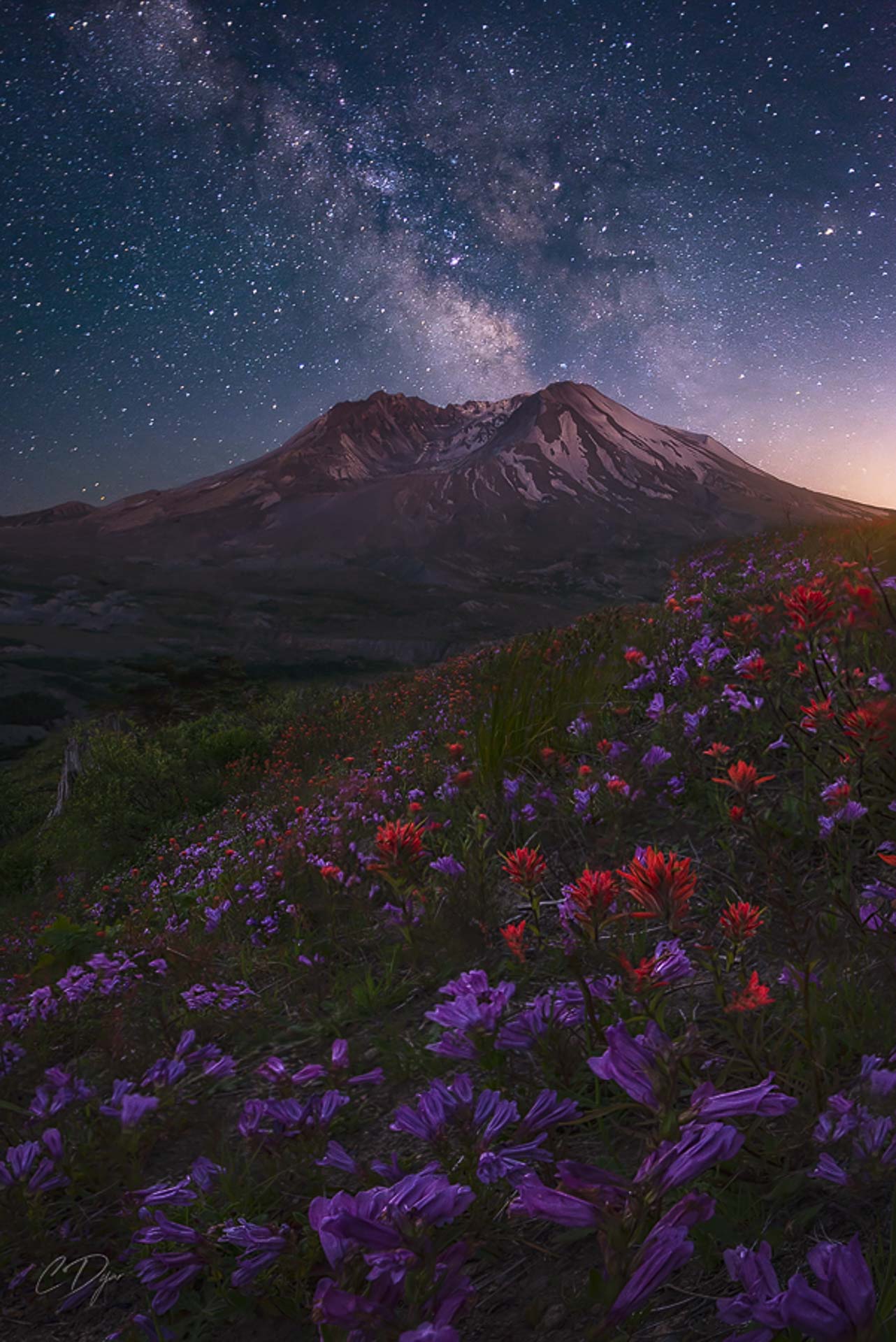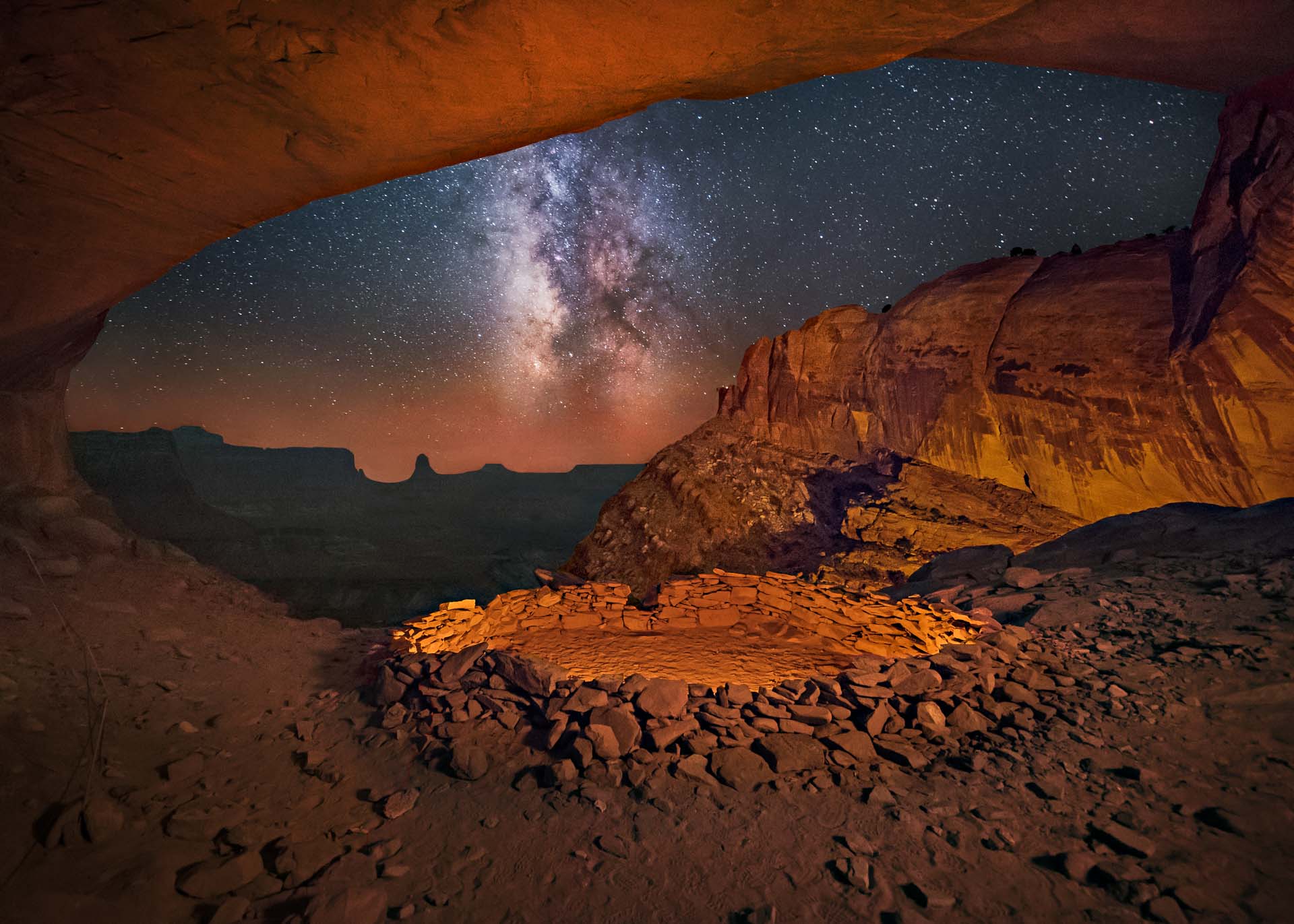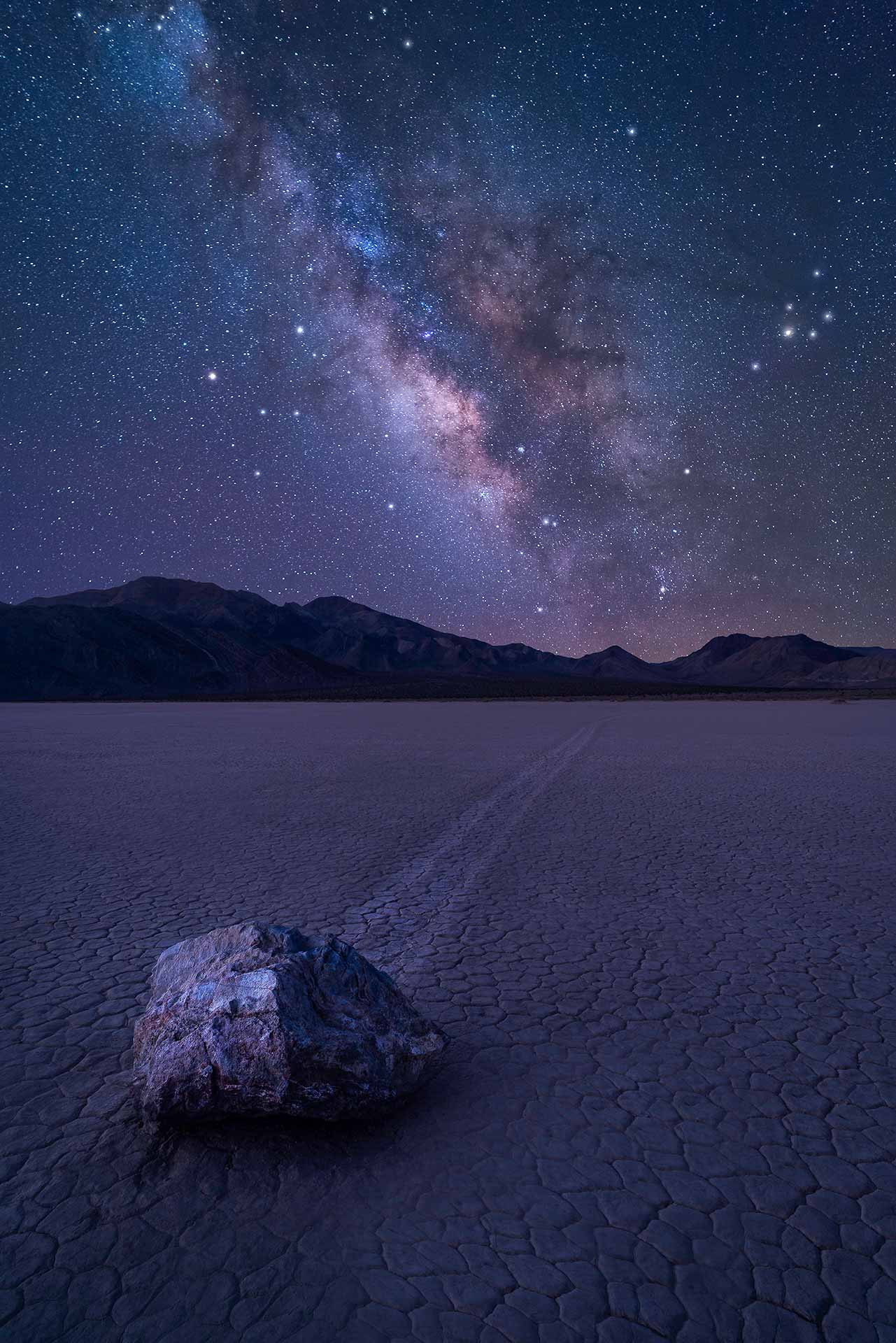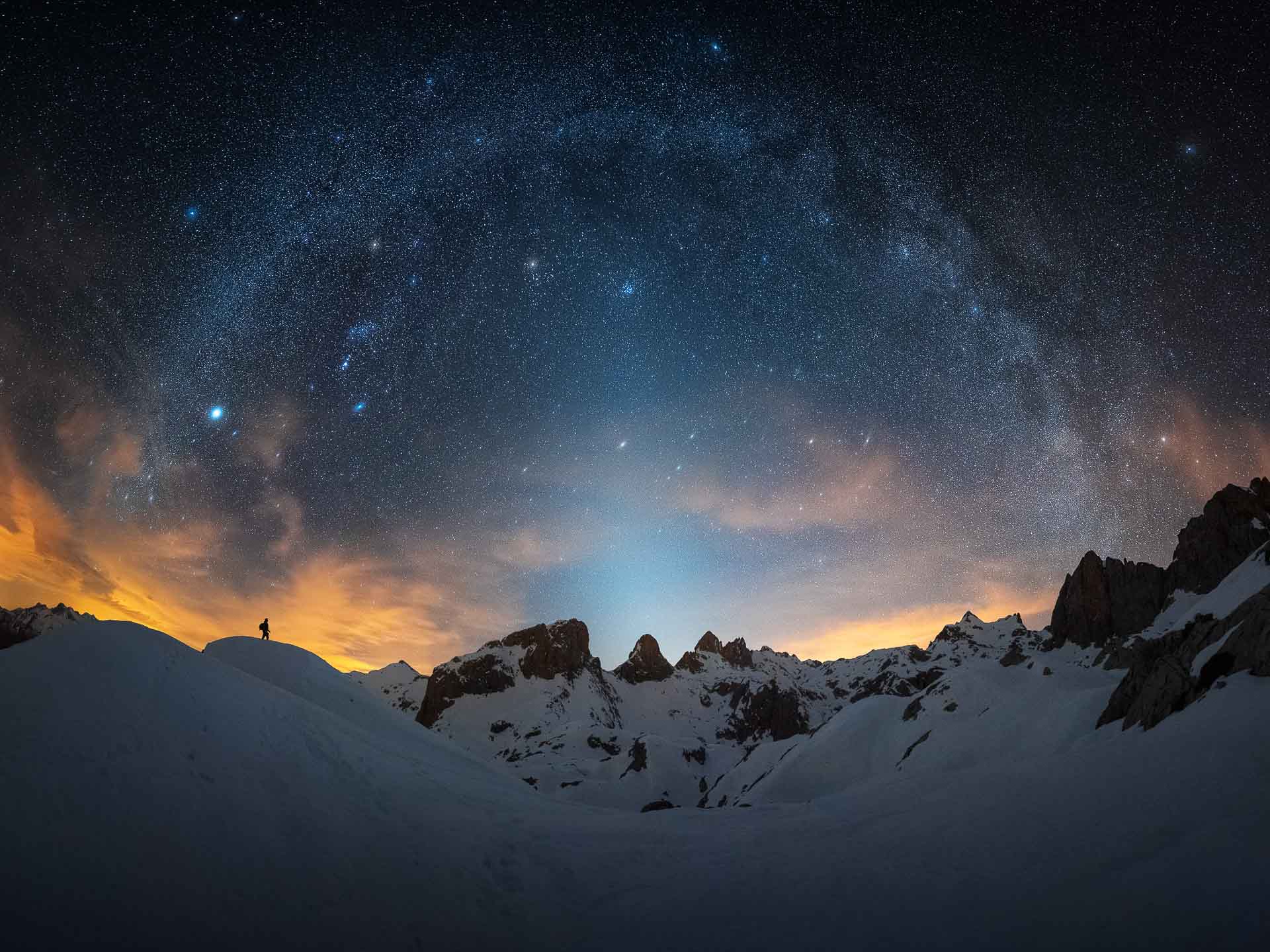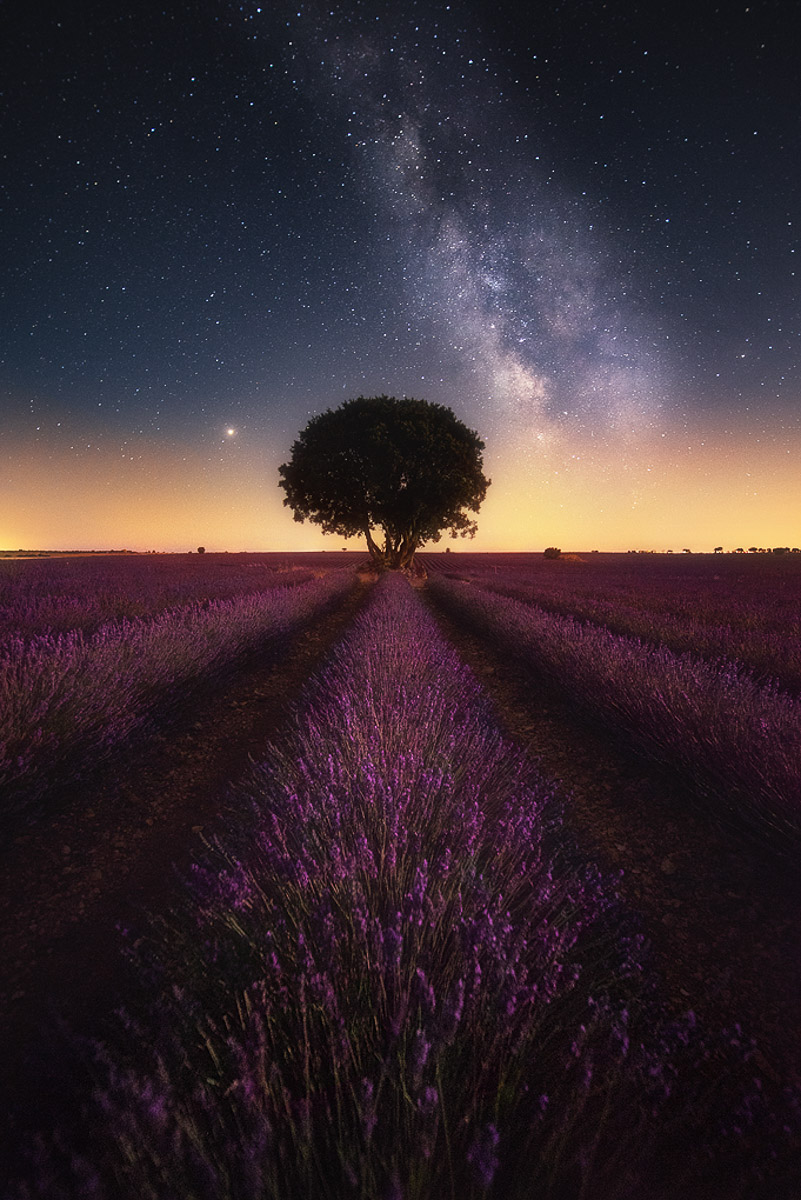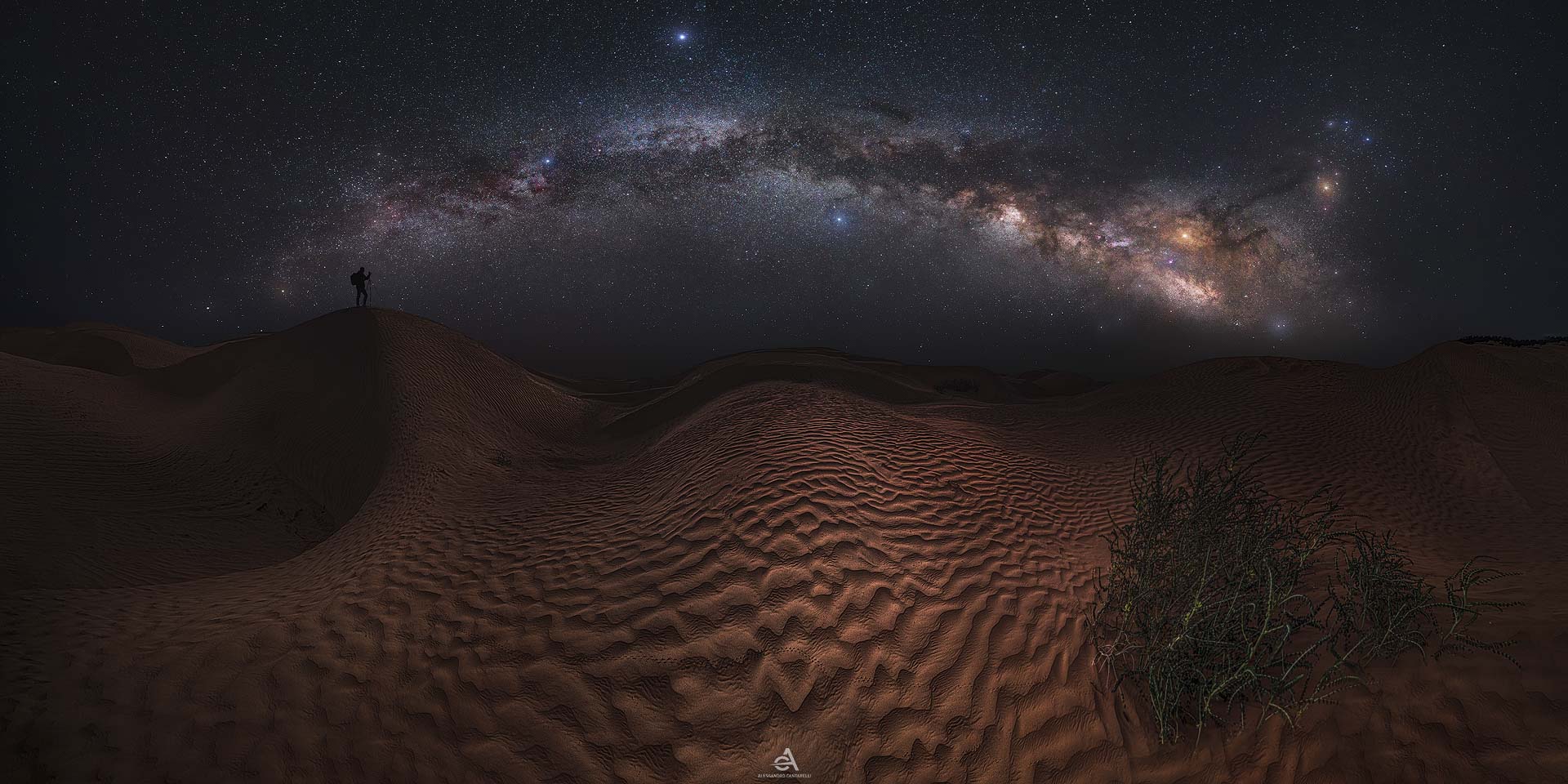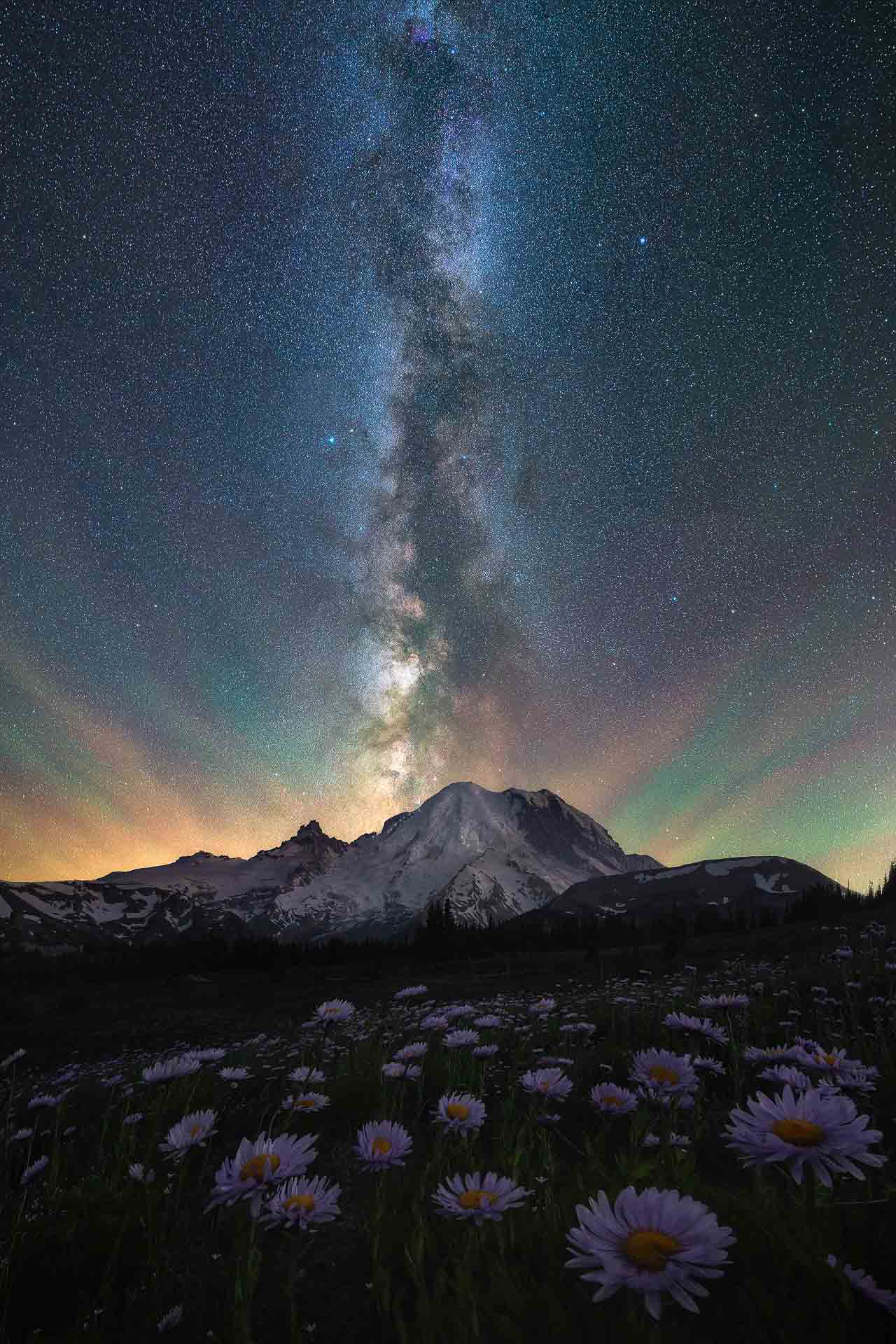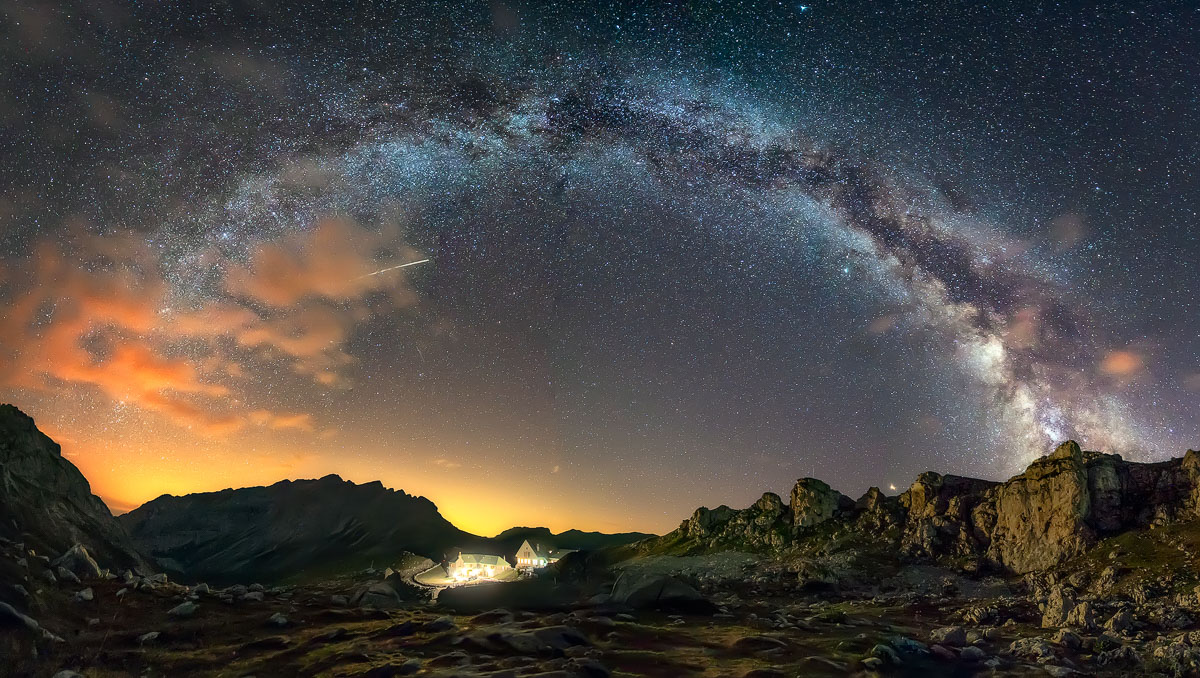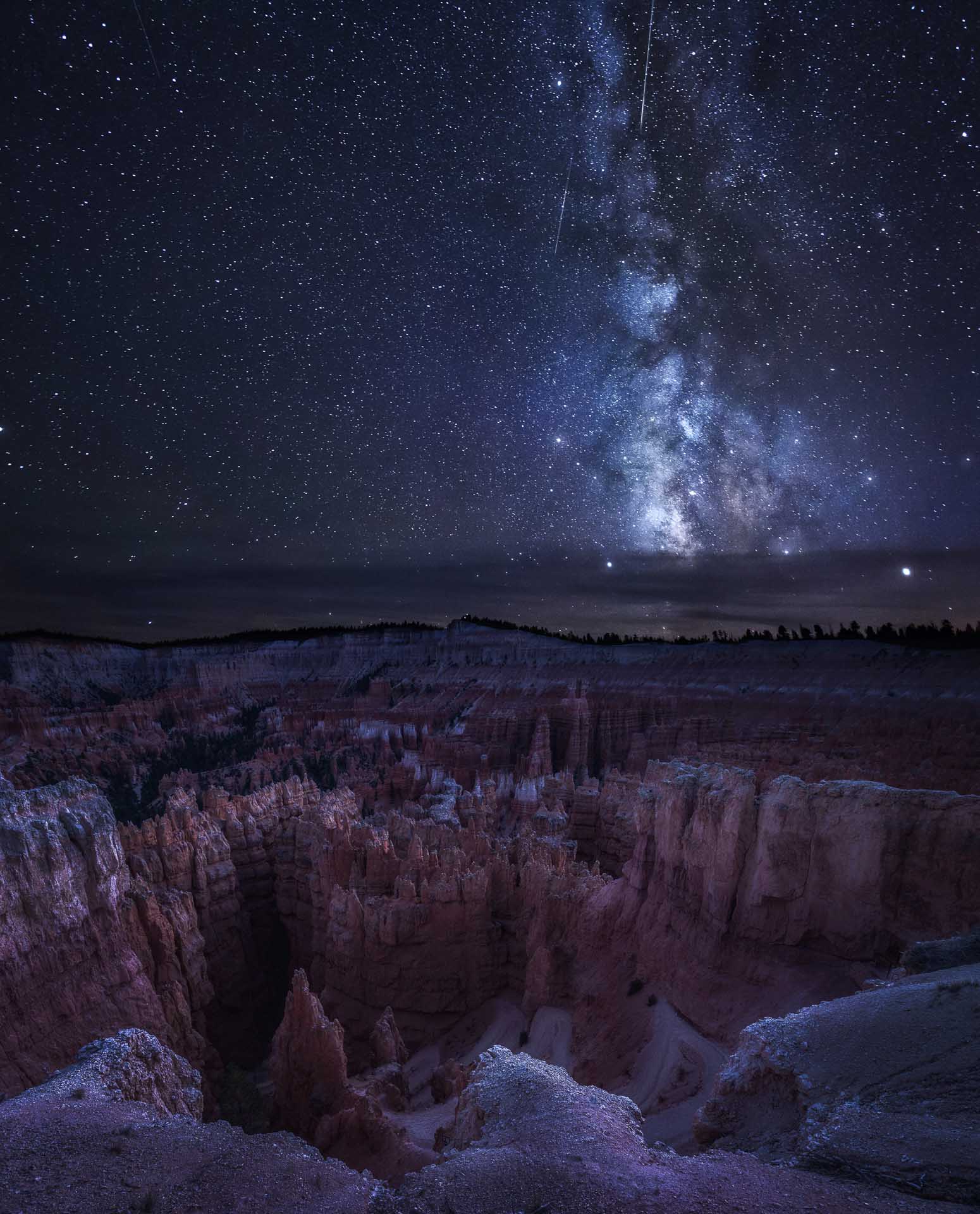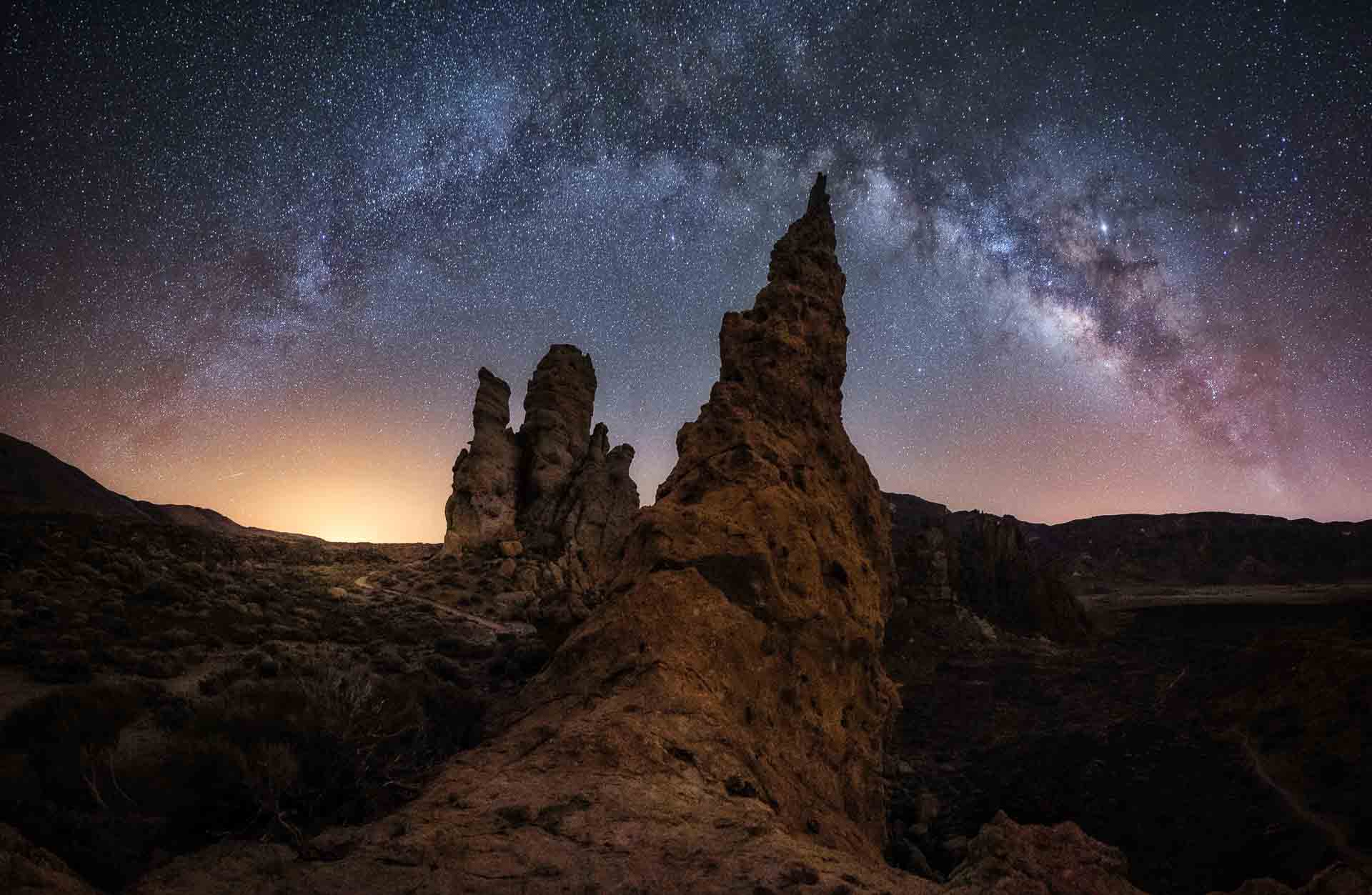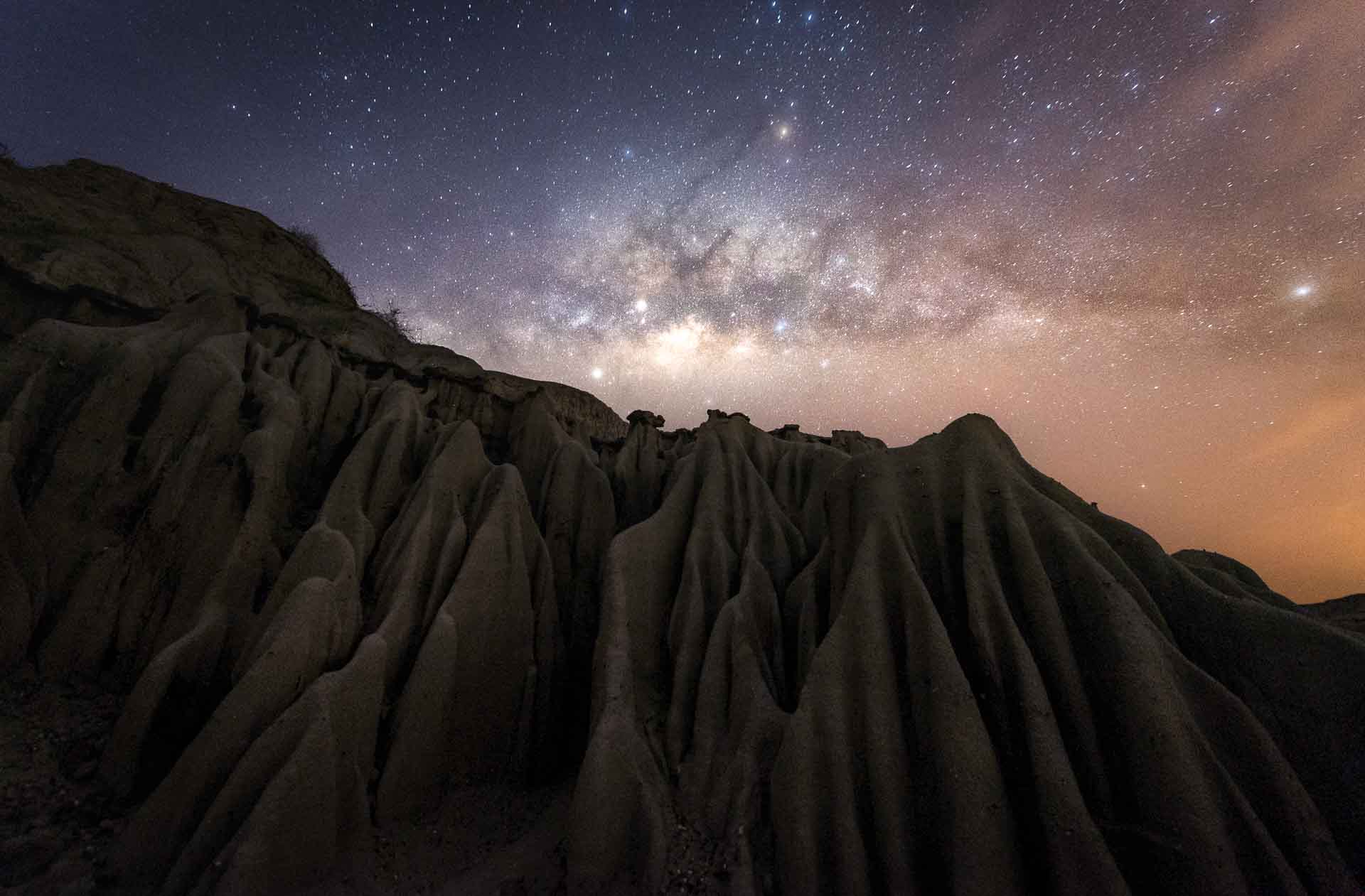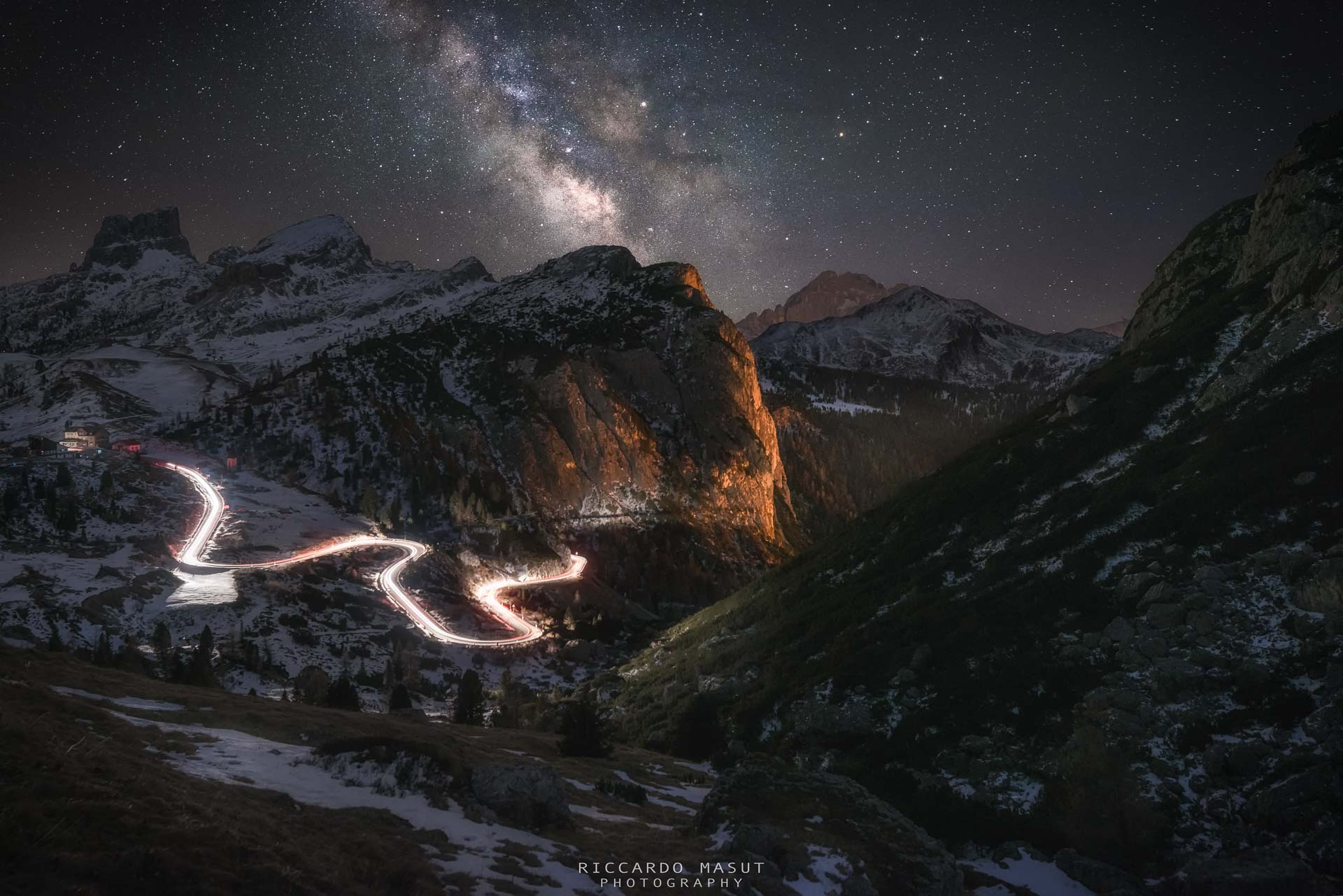THE 25 MOST INSPIRING MILKY WAY PICTURES
Photographing the Milky Way is one of the most fascinating experiences for any landscape photographer.
Roughly from roughly March to October, we’re lucky enough to be able to enjoy the sight of the magical Galactic Center: the core of our universe with millions of stars, nebulas, and massive black holes.
However, capturing this spectacular show is not as easy as it seems; it requires a good location away from light pollution, great planning, the right gear, and some technical knowledge. Finally, the secret ingredient is a good source of inspiration. That’s the reason why, in this article, we’ve gathered some of the best Milky Way photographs ever taken around the world.
From the remotest areas of North and South America to the end of the world in New Zealand, passing through places like Namibia, Indonesia, the Sahara Desert, and Europe, we will travel across the skies and see stars from all over the world, with photographers who, once upon a time, dreamed of taking these photos; we hope that they’ll make you dream today.
“Night of the Camels” – Olli Sorvari When doing astrophotography, it’s very common to struggle with light pollution. On my last trip to Morocco, we decided to make sure there would be no light pollution to bother us, so we headed to Merzouga Dunes, in the Sahara Desert. It was kind of a long shot because it can easily get windy in the Sahara, and sand storms are common during that time of the year. As the evening went on, we roamed around the dunes trying to figure out the possible foreground for the night image. At three o’clock, we woke up and snuck out of our tent, and the views we were facing were something from out of this world. I had never seen such a crisp and detailed starry sky, where everything looked so three-dimensional, almost as if you could reach the stars.“Night of the Camels” – Olli Sorvari
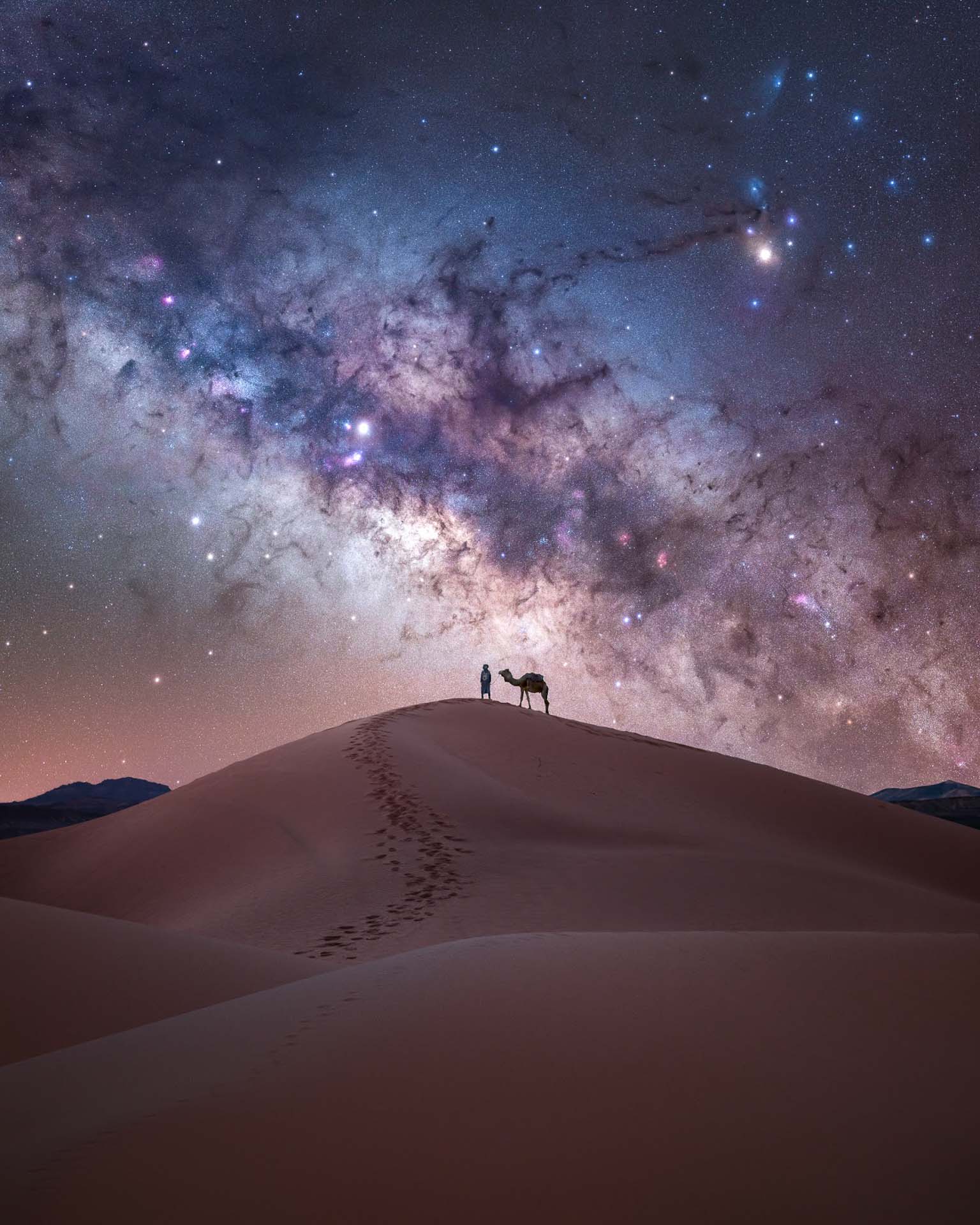
“Star Portal at the Uyuni salt flats” – Jheison Huerta The “Salar de Uyuni,” after the rainy season, becomes the most extensive natural mirror in the world, where it’s possible to photograph not only reflections during the day, but also reflections of the night sky. I was able to shoot this image after two consecutive years of frustrated attempts, which the weather did not help. Finally, in February of 2018, I was able to capture what I had in mind: the arch of the Milky Way reflected on the salt flat, a natural show captured in the memory of my camera and in my mind that I will never forget.“Star Portal At the Uyuni Salt Flats” – Jheison Huerta
“Milky Way over Bromo” – Fabio Antenore I took this picture during my recent scouting trip to Indonesia. The area around Bromo was at the top of my bucket list for a long time. When we arrived at the location, it was completely covered in fog. During the first day, the volcanoes were not visible at all. But as we woke up in the middle of the night during our second day, we had the perfect conditions: a layer of fog on the ground and clear skies, which allowed me to shoot the image I had in mind. The image is a time blending of two different shots: one of the Milky Way and another of the foreground.“Milky Way Over Bromo” – Fabio Antenore
“Road to the Galaxy” – Arpan Das This image was taken in Arizona in the summer of 2018. A lot of technical things went into this image. It is a sixteen-image panorama (eight for the sky and eight for the foreground). For the sky, I used a tracker, and each exposure took 2 minutes and 30 seconds at f/2.8, ISO 1600, 15mm. For the foreground, I used the stacking method to reduce noise. Each of the eight frames consists of stacking of five images with the same settings (2min, ISO 3200, 15mm, f/2.8). The light over the mountain came from the nearby towns, as the location is really close to Phoenix and other big cities. However, in this case, I could take advantage of the light pollution to create the image.“Road to the Galaxy” – Arpan Das
“Nocturnal souls” – Isabella Tabacchi One of the most majestic nights from my last trip to Namibia. It was incredible to see and photograph the night sky. It inevitably made me wonder about the experience of being in the heart of the Universe in one of the most impressive places on Earth.“Nocturnal souls” – Isabella Tabacchi
“The arch walker” – Nico Rinaldi Exploring this beautiful desert made me think of how small we are and how connected we are with the stardust. For me, it was very exciting to see those spectacular places with unique colors and shapes for the first time in my life. To take this photo, I concentrated on creating a simple and well-balanced composition. I will always remember this wonderful experience in the Utah desert.“the Arch Walker” – Nico Rinaldi
“Star Shadows” – Joshua Snow Shooting the stars in a place as dark as Death Valley is such a calming experience, when you’re so focused on the hustle, the grind, the pressure of capturing a shot, and all of a sudden all the noise and thoughts just stop and you’re surrounded by silence. It’s in those moments where you can really feel how small we are in this endless Universe.“Star Shadows” – Joshua snow
“The Milky Way and the unexpected Aurora” – Julio Castro My intention was to photograph the Milky Way using the famous stones of Moeraki Boulders; however, when I was making my way along the beach, the tide began to rise much faster than expected. I decided to improvise and capture the image in an area where I could take advantage of the beautiful reflection on the sand. When I saw the image in my camera, to my surprise, there was a faint southern Aurora Australis on the horizon that I would never have expected, and that makes this a unique and surprising photo.“The Milky Way and the Unexpexted Aurora” – Julio Castro
“The Temple of Ancient Knowledge” – Mike Sanchez Depicted is the core of the Milky Way glowing in the night sky above the iconic reflective pool at The Wave. It was shot on a Nikon D750 with a Rokinon 12mm fisheye lens. It is a blend of sixteen exposures, fifteen consecutive exposures of the sky and water reflection at f/2.8, ISO 12800, 15 seconds each (stacked in Starry Landscape Stacker for noise reduction to produce a final, cleaner, single image of the sky and water). The foreground was a single exposure shot minutes later at the start of blue hour; settings were f/2.8, ISO 1600, 4 minutes. Blended in Photoshop.“the temple of ancient knowledge” – Mike Sanchez
“The Legend” – Mauro Cirigliano This is, in my opinion, the most beautiful place in the Dolomites: a hidden lake at an altitude of almost 2,000 meters, which is surrounded by huge mountains and beautiful turquoise waters. The mountain above the lake is the symbol of this enchanted paradise. It is called “The Finger of God,” since it points up to the sky and is reflected in the lake, attracting the viewer’s eye. It was a real challenge to reach this location with a heavy backpack of over twenty kilos, but the result was completely worth it. I shot a 180-degree panorama to capture this paradise under the shining Milky Way. “The Legend” – Mauro Cirigliano
“One Starry night” – Giulio Cobianchi The Dolomites, in Italy, offer many scenic places to capture the Milky Way, such as valleys and mountain peaks. I took this photo at the “Cinque Torri,” one of the most symbolic places in the Dolomites during the spring season. That night, which I remember as one of the coldest nights sleeping under the stars, I waited for the right position of the Milky Way over the Cinque Torri, at four o’clock in the morning. This is my favorite kind of nightlife: being on top of the mountains watching a gorgeous starry sky.“One Starry NIGHT” – Giulio Cobianchi
“Si Yett Under the Stars”– Candace Dyar Si Yett is the Yakima Tribal name for Mount St. Helens and means “woman.” According to legend, Si Yett was a beautiful maiden placed on Earth by the Great Spirit to protect the Bridge of the Gods on the Columbia River from Mount Adams and Mount Hood, the battling brothers. Also known as Loowit by the Puyallup tribes, this mountain has long fascinated me due in part to its rich, mythical history and the legends that surround it. Witnessing the majesty of this area at night with the Milky Way is something that I believe can only be described as a spiritual experience. This image was taken during an especially windy evening, which made taking this image with wildflowers in the foreground all the more challenging, despite the higher ISO setting. I ended up getting lucky and managed to come away with a few images that didn’t include motion blur. This involved several images focus stacked for the foreground flowers during blue hour and a separate image taken later that evening for the sky. I hope that the overall end result conveys the feeling of wonder that I had being there. There’s nothing quite like sitting under the stars and seeing the Milky Way slowly appear right over a mountain peak in the wilderness.“Si Yett under the stars” – Candace Dyar
“Canyonlands NP as seen from the False Kiva Alcove” – Wayne Pinkston It’s difficult to step into the past and see the world as the ancients might have seen it. The signs of modernity permeate our lives. In locations such as this, we can at least glimpse the world as the ancients might have seen it. Quietness prevails far from the noise and light pollution of our modern society.“Canyonlands Np as seen from the false Kiva Alcove ” – Wayne Pinkston
“Aliens & Their Games” – Jess Santos Although it’s been scientifically proven how these stones move, local folklore says that aliens sit on the Grandstand and move them around the playa at night. Standing out in the dark looking up at the star-filled sky, I found it easy to see how one might begin to believe that. Shot as a blue hour blend.“Aliens and their games” – Jess Santos
“The Orion arm and the zodiacal light” – Pablo Ruiz Photograph taken in the Spanish “Picos de Europa,” at an altitude of almost 2.000 meters. It was a night at the beginning of March when conditions were still wintry. This wasn’t the photograph planned for that night, but we took the opportunity that was presented to us in the first hours after sunset to capture this panorama with the zodiacal light centered under the Orion arm of the Milky Way. It was the best photo of the night, since the sky ended up covered in clouds and, unfortunately, we couldn’t see or photograph the Galactic Center for the first time that year.“The Orion arm and the zodiacal light” – Pablo Ruiz
“The Tail of The Goddess” – Jose Ramos The details of the Milky Way are not easy to see if conditions aren’t perfect, but fortunately, we have the magic of light gathering devices at our disposal, showing us the things that exist which the eye cannot see. Beyond the use of powerful telescopes, there is also an incredible device at our instant disposal, right here on this planet, which has gained the capacity of being able to show us a part of this hidden cosmos: the photographic camera. During my photo-trip to the lavender fields of Brihuega, besides my extensive search for intense sunrises and sunsets, I just had to seize the opportunity and do some sessions of night photography. July is not the perfect month to capture the Milky Way, as its position is considerably high in the sky when it gets dark, but the lavender lines and trees made a perfect complement to an almost vertical Milky Way.“Jose Ramos” – The Tail of the goddess
“Alone” – Alessandro Cantarelli It is rather difficult for me to explain what it feels like to experience a night in complete solitude in the Sahara Desert. It’s not just photography or a passion for astronomy; it’s an incredibly fascinating life experience. It took five minutes at ISO 800 f4 to capture every frame of this panorama showing all the details of the stardust of our galaxy, using the Skywatcher Star Adventurer on my camera.“Alone” – Alessandro Cantarelli
“Milky Way and wildflowers over Mt Rainier” – Ross Schram VH I grabbed this shot during an overnight trip to Mt Rainier National Park. It’s a spot I had frequently visited that year with the hopes of creating something unique at an overshot location. Everything lined up perfectly that night and I finally walked away with something I was happy with. I will never forget the feeling I got after looking at the LCD on my camera and seeing the symmetrical streaks of airglow and light pollution framing Mt Rainier with the Milky Way arm reaching up into the darkness.“Milky Way and Wildflowers over Mt Rainier”- Ross Schram VH
” The mountain hut under the stars” – Ignacio Municio After borrowing a new large aperture lens for astrophotography (Laowa 12mm), I tried to take the panorama shot in a single line and surprisingly, it worked. This place is located in the idyllic setting of the Cantabrian part of the Spanish “Picos de Europa,” where the nights are unique. The light coming from the mountain hut was intense, but it was completely worth it. Frequently, the more isolated you are from civilization, the more you enjoy these beautiful nocturnal landscapes.“the Mountain hut under the stars” – Ignacio Municio
“Milky Way at Bryce Canyon” – Sandra Metzbauer I spent a freezing night shooting a sky full of stars at one of the most spectacular places in Utah: Bryce Canyon. As soon as the sun sets, people leave, and the Canyon turns into an abandoned mystical location. After a nice sunset, I waited in my car until the sky was dark enough to shoot the night sky, and what I got to see made me speechless: countless stars and a breathtaking clear Milky Way like I had rarely seen before.“Milky Way at Bryce Canyon” – Sandra Metzbauer
” Galactic arch over the “Roques de García ” – Efrén Yanes Panorama composed of nine vertical photos to capture the entire galactic arch. This photo was taken in March, almost at dawn; the Galactic Center rises over the horizon at that time of the year. I wanted to take advantage of the different shapes of this famous rock formation in Tenerife also known as “Los Roques de García,” where you have endless composition possibilities to play with. Having the chance to see and shoot these skies with hardly any light pollution is something fascinating.“Galactic arch over the Roques de garcia” – efrén yanes
“Congress of the Ghosts” – Camilo Jaramillo The labyrinths of the Tatacoa Desert are one of the most spectacular night photography spots in Colombia, with places like “the Cuzco Labyrinth” or “the Holes”, where this photograph was taken. It was a night in early March last year; we’d ventured into the desert to welcome the Milky Way season. I had always dreamed of a picture like this, inside a dark and fascinating desert that is actually a dry and tropical forest. Once there and, taking into account that at that time of the year the Galactic Center crosses the horizon past 2:00 am in Colombia, after exploring the surroundings of the place, I found a location that caught my eye; seeing the amount of clouds, I decided to leave the camera on all night long. I left it shooting automatically with the intervalometer just in case. My surprise came the next morning, when, among the hundreds of photographs, I found one where the sky had opened to show the majestic Milky Way.“Congress of the Ghosts” – Camilo Jaramillo
“The Guardian of the Arch” – JOSE D Riquelme
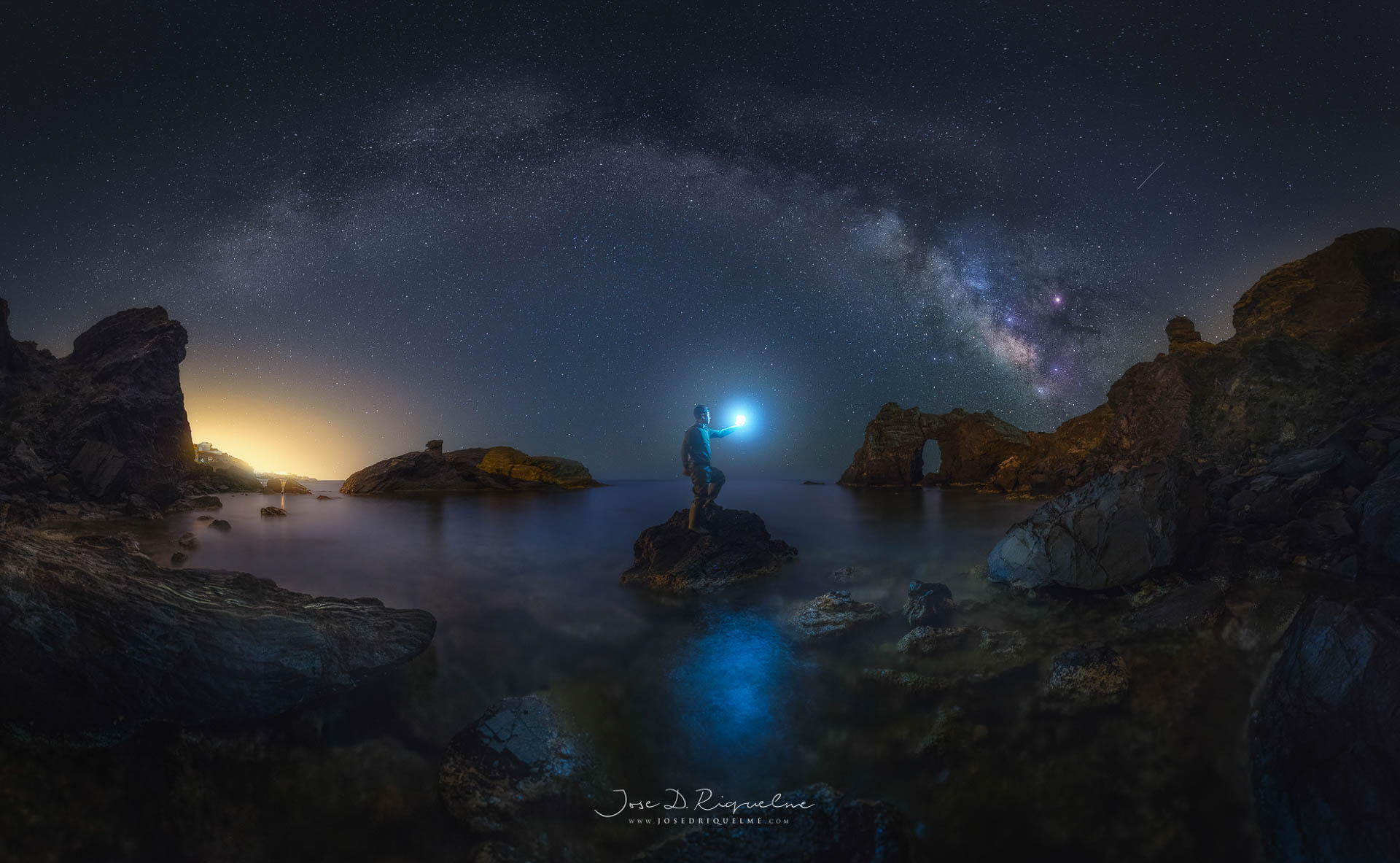
“The Guardian of the arch” – Jose D. Riquelme
- Arco de los Reyes-Murcia, Spain
Ever since the first time I saw this location, I wondered what a photograph of the Milky Way arch over this natural rock arch would look like.
Accessing this place is a bit tricky, and it took us two tries to enter the main shooting point. Unlike other coastal locations, here, you need to consider the tides and waves, since you need a day with a calm sea to get in.
With the water up to my waist, I started trying different compositions until I found the perfect one for that night.
“A Dolomitic night” – Riccardo Masut A cold, late-spring night at the Falzarego pass, one of the most beautiful mountain passes in the Dolomites. After a splendid, sunny day spent walking along the paths of the mountain pass, the night welcomed us with a magnificent Milky Way rising over the snowy peaks.“A Dolomitic Night” – Riccardo Masut
Hope these images encourage you to go out and chase the beauty of the night skies.
Also, don’t forget that the most important thing for photographing the Milky Way is the right planning. You can download Milky Way Calendars according to your location to know the best days and times to capture the galaxy.
Thank you for sharing this article with other friends and colleagues who might find it inspiring.
…and just before you leave…You can receive more inspirational articles, photography guides, and more photo tips and resources by simply subscribing to our community. We would be happy to have you in this group of passionate and like-minded photographers!
Below you can find the gallery with all the images at full size. Enjoy it!
Please do not download, copy or share any of the photos here without the author’s prior written permission. Consider the photos here to be protected by copyright. If anyone uses any of the photographs we will take the required legal actions.

